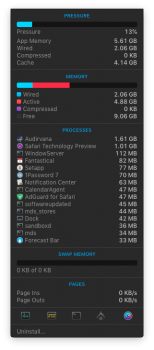From here :
https://www.cnet.com/news/how-to-invoke-and-interpret-the-apple-hardware-tests/
The error codes
If the tests determine there is an error with your system, they will display an error code similar to the following:
4SNS/1/1/4000000 TL0P-130
The codes may be a bit cryptic, but you can contact Apple Support to see what they mean. As a general reference, here are some of the breakdowns for what the error codes mean, so if you see an error that begins with one of these codes, then it means the specified component listed at the end of the code is not working properly:
4ETH: Ethernet controller
4IRP: Main Logic board
4MLB: Logic board controller
4PRC: Processor
4HDD: Hard disk
4MHD: External disk
4YDC: Video card
4SNS: System sensor
4MOT: Fan motor
4MEM: Memory module
4AIR: AirPort wireless card
In the case of a sensor error (4SNS), to determine what type of sensor is being referenced, check its first letter, which should either be "I" for current, "T" for temperature, or "V" for voltage. Then check the second letter against the following list to see what component it refers to:
A: Ambient air sensor
B: Battery
C: Central processors (CPU)
D: DC (direct current)
e: PCI-express slot
F: FireWire port
G: Graphics processor (GPU)
H: Hard disk
h: Heat pipe (heat sink)
L: LCD display
M: Memory or memory riser boards
m: Misc. (i.e., battery chargers)
N: North bridge (motherboard controller)
O: Optical drives
P: Power bus
p: Power supply
s: Palm rests for laptops
W: Airport Wi-Fi card
In the example mentioned above, a sensor called "TL0P-130" is not working properly, which is an LCD temperature sensor in a portable system.
What to do
When it comes to addressing the error code situation, unfortunately many times there's not much that you can do. In most cases if a hardware component is not working then you will need to get it replaced; however, there are some instances where you can try another step or two before having your system serviced.
If you get an error that deals with an Ethernet controller, the main logic board, a logic board controller, processors, or sensors, then try rebooting the system and
resetting the system PRAM to see if the problem clears. If you are getting a problem with the fan speeds or any sensors then you can also try
resetting the system management controller, but in addition to these resets do check the fans for physical obstructions (dust and dirt) or for mechanical issues.
If you see a memory or AirPort card error code, then your best bet would be to first try resetting them in their connections on the motherboard, but ultimately replace them if you cannot get the errors to go away on subsequent tests. If you are unable to perform these tasks yourself, then you should be able to have it done at an Apple Store.


